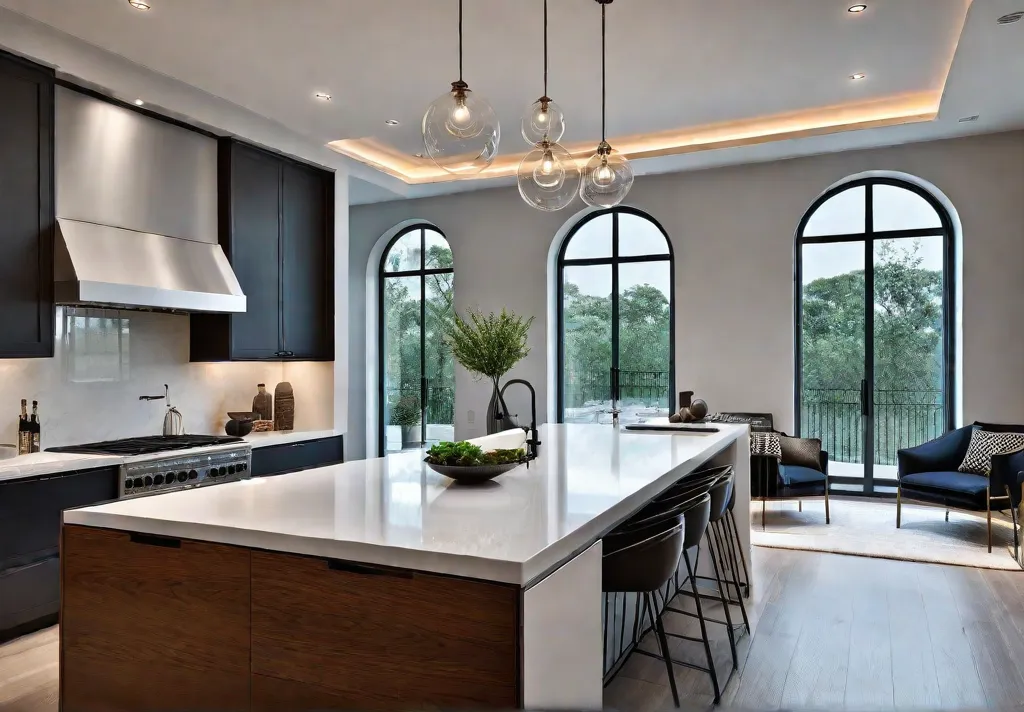Have you ever walked into a friend’s kitchen and felt an instant warmth and coziness despite its compact size? The secret often lies in the power of thoughtful lighting design. Just like the perfect accessories can elevate a simple outfit, the right illumination can transform even the tiniest cooking nook into an inviting, functional haven.
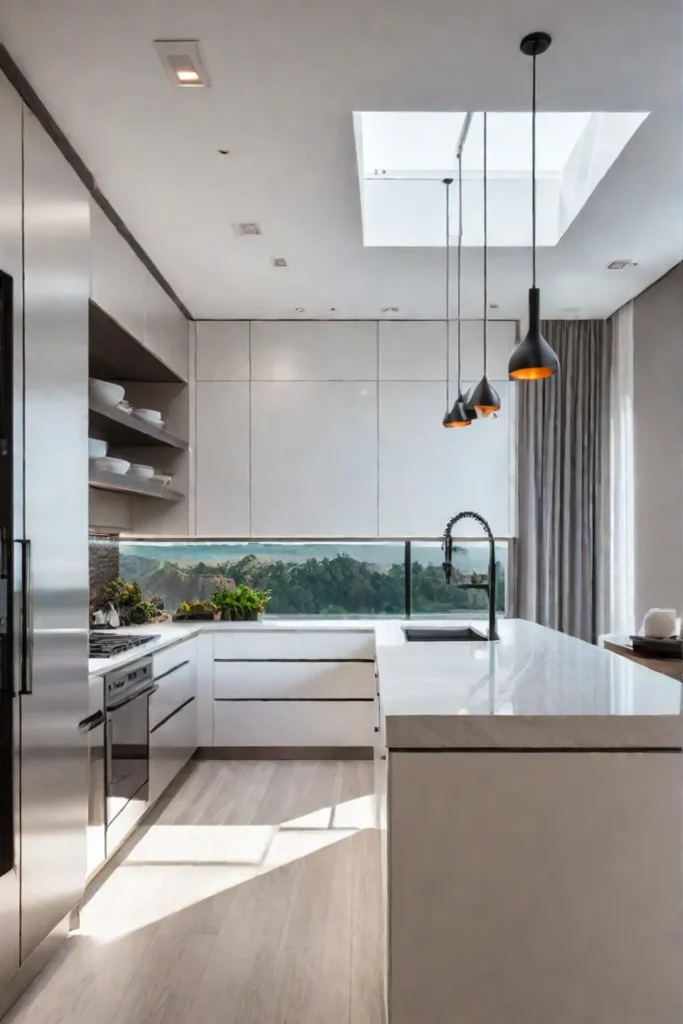
As someone with a deep appreciation for the stories behind beautiful spaces, I’ve witnessed firsthand how strategic lighting can breathe new life into a small kitchen. Imagine soft, golden light dancing across your heirloom china or task lighting that makes intricate culinary tasks feel effortless. You can create spacious, stylish, and unique kitchens with a few bright ideas.
Under-Cabinet Lighting: Radiant Illumination at Your Fingertips
Under-cabinet lighting is a game-changer for small kitchens. It provides essential task lighting while accentuating the beauty of your countertops and backsplash. These discreet yet impactful fixtures come in various forms, each offering a unique charm.
LED under-cabinet lights, for instance, are a favorite among energy-conscious homeowners. Not only do they boast an impressive lifespan of up to 50,000 hours, but their warm, even glow can instantly elevate the ambiance of your space. Puck lights, with their compact, recessed design, offer a sleek and unobtrusive solution, while strip lights elegantly trace the contours of your cabinetry, casting a gentle radiance.

When selecting under-cabinet lighting, consider the fixture type, color temperature, and brightness. A warm, soft white (around 2700K) can create a cozy, inviting atmosphere, while cooler tones (3000K and above) lend a more energizing, task-oriented vibe. And don’t be afraid to experiment with dimmers – they allow you to effortlessly adjust the mood, from a vibrant workspace to a romantic, candlelit dinner setting.
Pendant Lights: Sculptural Accents that Elevate and Delight
Pendant lights are more than mere illumination sources; they’re sculptural accents that can add depth, visual interest, and a touch of whimsy to even the most modest kitchen. When chosen thoughtfully, these hanging fixtures become true works of art, catching the eye and drawing it upward to create the illusion of expansive vertical space.
The key to successful pendant lighting in a small kitchen lies in scale and proportion. Opt for fixtures that complement the size of your space, ensuring they don’t overpower or feel dwarfed by their surroundings. Consider grouping multiple pendants, creating a cohesive, coordinated display that adds visual weight and a sense of intentionality.
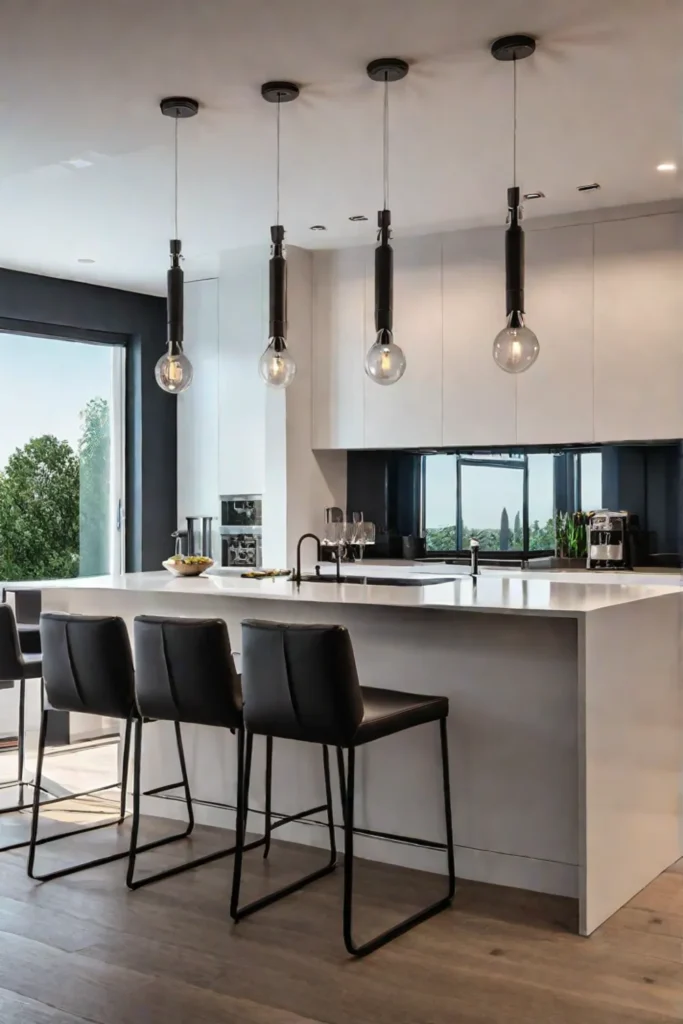
Pendant lights also offer a unique opportunity to layer lighting, a vital technique for achieving a balanced, well-lit small kitchen. Combine them with under-cabinet task lighting and perhaps a few well-placed recessed lights, and you’ll create a dynamic, multi-dimensional illumination scheme that caters to every need, from meal prep to casual dining.
Track Lighting: Flexible Illumination, Tailored to Your Needs
If versatility is your top priority, look no further than track lighting. This adaptable solution allows you to direct light precisely where you need it most, whether over a bustling prep zone or highlighting a treasured architectural feature.
One key benefit of track lighting in small kitchens is its energy efficiency. Track lights can consume up to 50% less electricity compared to traditional recessed lighting, making them an eco-friendly and cost-effective choice. Plus, their adjustable nature means you can fine-tune the light direction and intensity as your needs evolve, ensuring your kitchen remains a well-lit, functional space for years to come.

When selecting track lighting fixtures, consider both form and function. Sleek, minimalist designs can blend seamlessly into your decor, while more sculptural options can serve as visual focal points. And don’t be afraid to get creative with your layout – strategically positioning tracks can help guide the eye and create a sense of depth, making your compact kitchen feel more expansive.
Maximizing Natural Light: Embracing Nature’s Radiance
There’s something undeniably uplifting about natural light, and in a small kitchen, it can be a powerful ally in creating a bright, airy atmosphere. By embracing and optimizing the natural illumination in your space, you’ll enhance the perceived size and foster a connection with the great outdoors, a cherished New England tradition.
Start by considering your color palette. Light, reflective hues on walls, cabinets, and countertops can amplify the effects of natural light, bouncing it around the room and creating a sense of openness. Glossy tiles, stainless steel appliances, and strategically placed mirrors can enhance this effect in effect-catching surfaces that disperse radiance throughout the space.
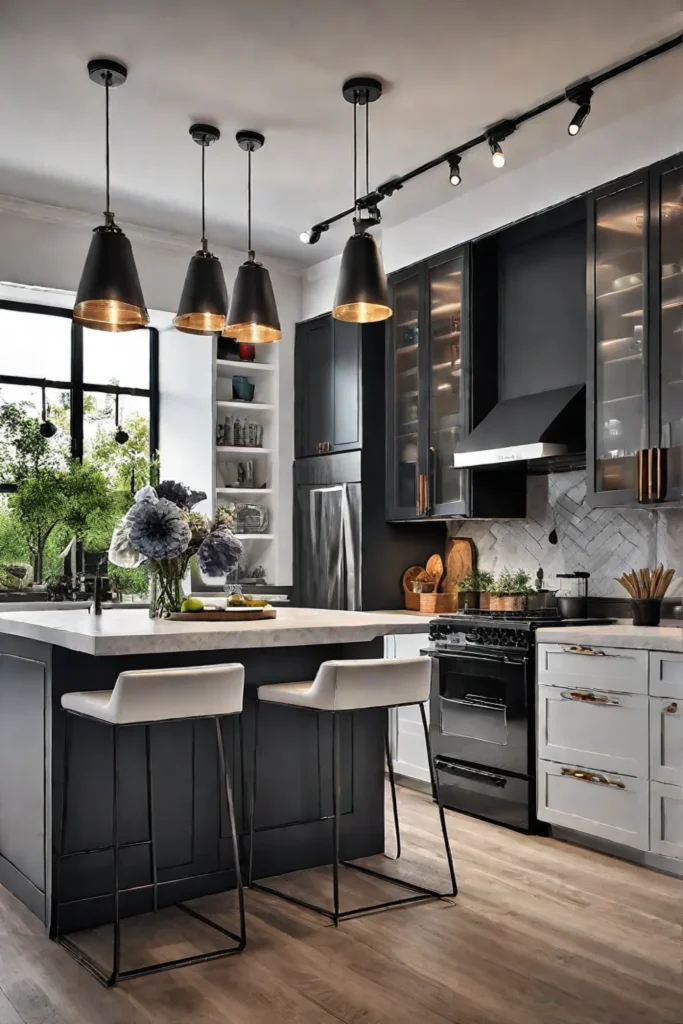
Of course, the true key to maximizing natural light lies in your windows. If possible, consider enlarging or adding new openings to invite more of the outdoors in. Skylights can also be a game-changer, flooding your kitchen with warm, overhead illumination that mimics the soft glow of a summer day.
However, natural light alone may not meet all your lighting needs. Layer it with strategically placed artificial sources, such as under-cabinet lights or pendants over work zones, to create a balanced, well-lit space that caters to every task and mood.
The Art of Layered Lighting: Creating Depth and Ambiance
In a well-designed small kitchen, lighting is not just a functional necessity but an art form—a carefully orchestrated interplay of task, ambient, and accent illumination that collectively creates a sense of depth, warmth, and visual interest.
Layering lighting is the key to achieving this harmonious balance. Start with task lighting, those focused sources illuminating specific work zones, like under-cabinet lights or pendants over prep areas. Then, introduce ambient lighting – perhaps a few well-placed recessed lights or a central semi-flush mount – to provide overall illumination and a sense of spaciousness.
Finally, add the finishing touches with accent lighting. These elements highlight your kitchen’s unique character, whether a decorative sconce that casts a warm glow over your heirloom china or a strategically placed track light that draws the eye to a stunning backsplash.

As you layer these various sources, pay close attention to the interplay of light and shadow. Subtle contrasts can create depth and dimension, transforming your compact kitchen into a dynamic, multi-faceted space that feels functional and inviting.
Highlighting Beauty: Illuminating Your Kitchen’s Unique Character
In a small kitchen, every inch counts – and strategic lighting can be the secret weapon that helps you make the most of your available space while showcasing your unique style.
One powerful technique is lighting, accentuating architectural features or focal points. A well-placed track light or adjustable recessed fixture can draw the eye to a stunning range hood or a beautifully tiled backsplash, transforming these elements into true showstoppers.
Lighting can also be used to highlight specific work zones or prep areas. A pendant light over a kitchen island, for instance, not only provides ample task lighting but also creates a warm, welcoming ambiance that invites casual gatherings and lively conversation.
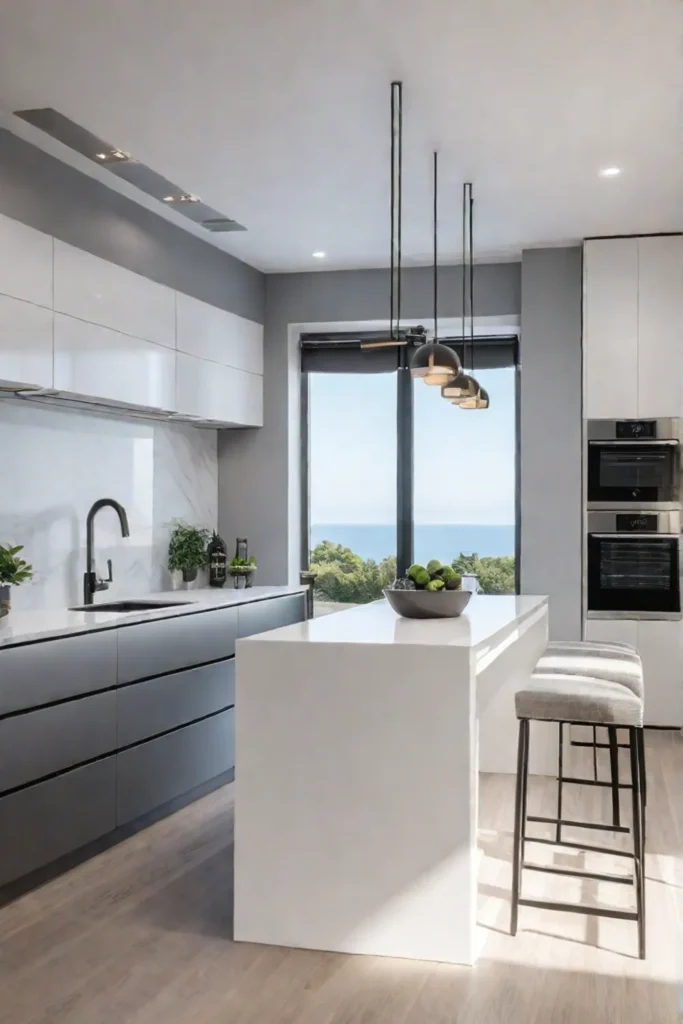
However, perhaps the most magical use of lighting in a small kitchen is its ability to create a sense of depth and dimension. By strategically layering and directing light sources, you can play with shadows and highlights, guiding the eye through the space and creating the illusion of expansiveness.
The Power of Color: Brightening Your Space with Reflective Hues
While lighting is undoubtedly the star of the show when it comes to brightening a small kitchen, color can be a powerful supporting act. By embracing light, reflective hues, and strategic pops of vibrant accents, you can amplify the effects of your carefully curated illumination scheme.
Start with a base of soft, neutral tones – warm whites, gentle grays, or soothing creams. These light-reflecting hues can make even the most compact kitchen feel airy and open, bouncing light around the space and creating a sense of expansiveness.
Then, introduce pops of color through accessories, textiles, or small-scale furnishings. A cheerful yellow vase, a vibrant patterned rug, or a row of colorful ceramic canisters can add visual interest and energy, drawing the eye and creating focal points that enhance depth perception.
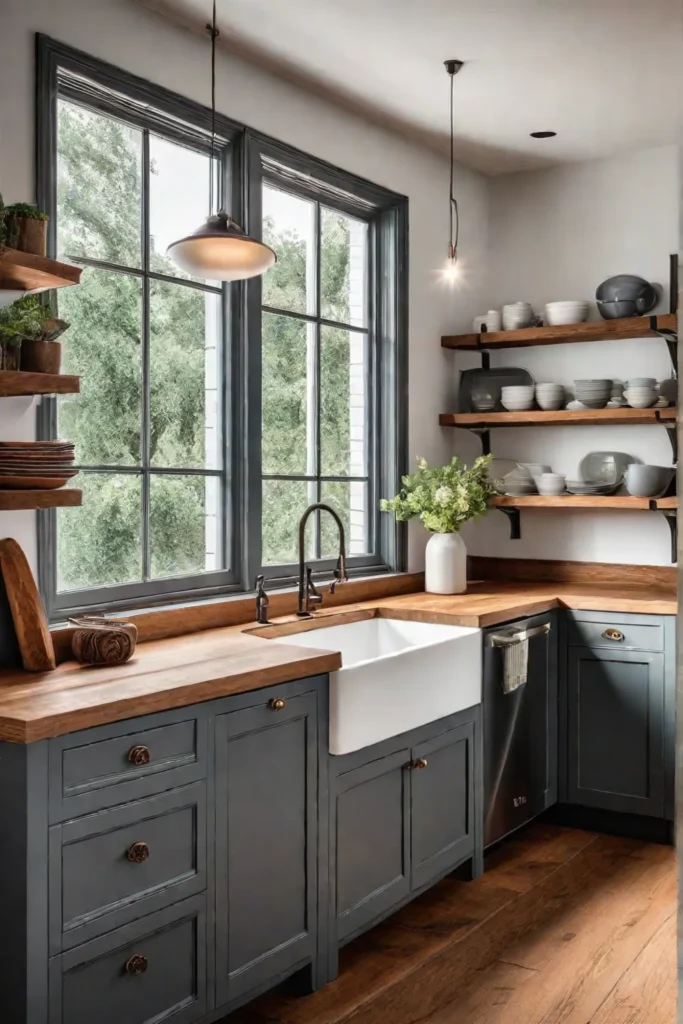
But don’t stop there – consider incorporating reflective surfaces, like glossy subway tiles or sleek stainless steel appliances. These light-catching elements can further amplify the effects of your lighting design, creating a luminous, radiant atmosphere that feels stylish and inviting.
Bringing it All Together: A Harmonious Blend of Light and Style
As you transform your small kitchen into a bright, welcoming haven, remember that the true magic lies in the harmonious blending of various lighting solutions and design elements.
Start by integrating various lighting sources – under-cabinet task lights, pendant focal points, and perhaps well-placed recessed or track fixtures. Layer these elements thoughtfully, creating a balanced interplay of illumination that caters to every need, from meal prep to casual dining.
Then, consider how your lighting choices complement the overall aesthetic of your kitchen. Do the fixtures’ finishes and styles align with your cabinetry, countertops, and hardware? Do the color temperatures and intensities enhance or detract from the room’s ambiance?
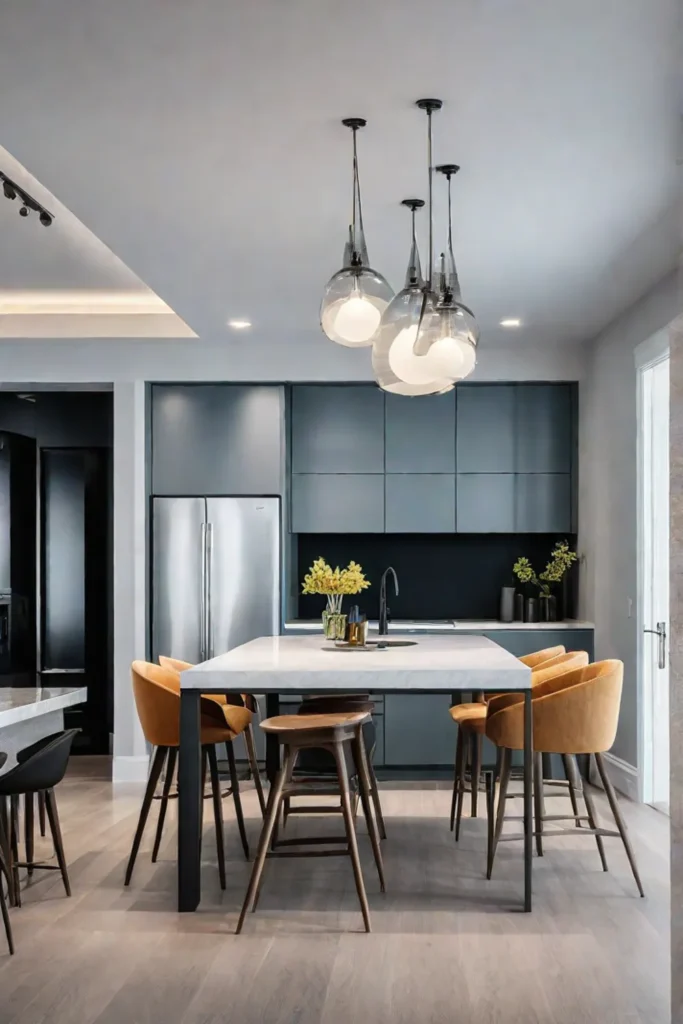
Throughout this process, consider both practicality and aesthetics. A well-lit kitchen should be beautiful and functional, with ample task lighting and strategic accent illumination that highlights your space’s unique character.
And remember, the true beauty of a small kitchen lies not in its size but in its ability to reflect the warmth, personality, and cherished stories of those who inhabit it. With the right lighting design, you can create a bright, functional, and radiant space – a cozy haven that invites you to linger, build, and make lasting memories.
Ultimately, illuminating your small kitchen is more than just adding light sources; it’s about crafting an environment that nourishes the soul and body. So embrace the challenge, let your creativity shine, and watch as your compact cooking nook transforms into a space that feels truly luminous, stylish, and uniquely yours.
